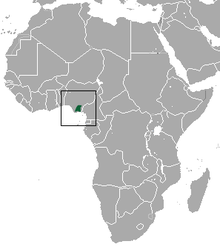
The guenons are Old World monkeys of the genus Cercopithecus. Not all members of this genus have the word "guenon" in their common names; also, because of changes in scientific classification, some monkeys in other genera may have common names that include the word "guenon". Nonetheless, the use of the term guenon for monkeys of this genus is widely accepted.

The blue monkey or diademed monkey is a species of Old World monkey native to Central and East Africa, ranging from the upper Congo River basin east to the East African Rift and south to northern Angola and Zambia. It sometimes includes Sykes', silver, and golden monkeys as subspecies.

The white-throated guenon, also known as the red-bellied monkey and the red-bellied guenon, is a diurnal primate that lives on trees of rainforests or tropical areas of Nigeria and Benin.
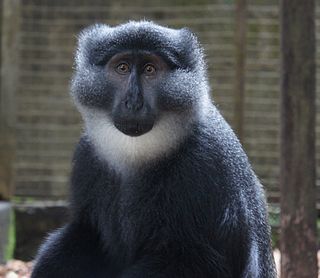
The Preuss's monkey, also known as Preuss's guenon, is a diurnal primate that lives terrestrially in mountainous forests of eastern Nigeria, western Cameroon and Bioko in Equatorial Guinea. It was formerly classified as a subspecies of the L'Hoest's monkey.
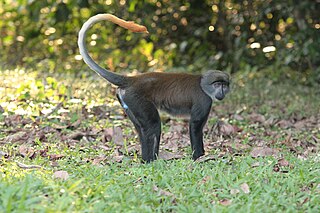
The sun-tailed monkey from Gabon is one of the least studied primates in its habitat. It was discovered as a new species in 1988, and is classified as a guenon, which is a member of the genus Cercopithecus, but was subsequently moved to the genus Allochrocebus. It is closely related to A. preussi and A. Ihoesti, which has been determined by chromosomal analysis. Sun-tailed monkeys prefer shady areas with dense vegetation. However, even after small amounts of logging activity, populations can be unaffected. Much of their diet remains unknown and is still being studied, but they are known to prefer fruit. Their social groups are made up of one male and multiple females. Generally, the sun-tailed monkey is less aggressive towards related individuals, which is noteworthy because it has been found that, in other primate species, aggression rates towards related individuals are generally as high or higher than aggression rates towards non-related individuals. Within their social groups, individual monkeys show preference for their mothers over their fathers, and are overall less aggressive to other monkeys that they are associated with spatially.

De Brazza's monkey is an Old World monkey endemic to the riverine and swamp forests of central Africa. The largest species in the guenon family, it is one of the most widespread arboreal African primates. Aside from size, it can be differentiated from other Cercopithecus monkeys by its orange diadem and white beard. Due to its cryptic nature, the species is not well documented in all of its habitats but has shown unique traits, such as pair-bonding and aggressive behavior towards other guenons.

The mona monkey is an Old World monkey that lives in western Africa between Ghana and Cameroon. The mona monkey can also be found on the island of Grenada as it was transported to the island aboard slave ships headed to the New World during the 18th century. This guenon lives in groups of up to thirty-five in forests. It mainly feeds on fruit, but sometimes eats insects and leaves. The mona monkey has brown agouti fur with a white rump. Its tail and legs are black and the face is blue-grey with a dark stripe across the face. The mona monkey carries food in cheek pouches.
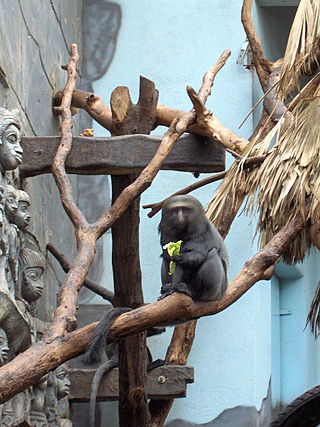
The Hamlyn's monkey, also known as the owl-faced monkey, is a species of Old World monkey that inhabits the bamboo and primary rainforests of the Congo. This species is exceedingly rare and known only from a few specimens; little is known about it. However these specimens tend to be widely dispersed throughout the eastern part of Congo, from the Epulu River to the Lukuga River and from the Congo River to the Kabale Forest, with one example in northwestern Rwanda. Geographically it corresponds quite closely to another species of monkey, L'Hoest's monkey C. lhoesti. It travels on the ground, and researchers think that it may be awake primarily by night.

L'Hoest's monkey, also known as the mountain monkey, is a guenon found in the upper eastern Congo Basin. They mostly live in mountainous forest areas in small, female-dominated groups. They have a dark coat and can be distinguished by a characteristic white beard.

Wolf's mona monkey, also called Wolf's guenon, is a colourful Old World monkey in the family Cercopithecidae. It is found in central Africa, primarily between the Democratic Republic of the Congo and Uganda. It lives in primary and secondary lowland rainforest and swamp forest.

The moustached guenon or moustached monkey is a species of primate in the family Cercopithecidae. It is found in Angola, Cameroon, Central African Republic, Republic of the Congo, Democratic Republic of the Congo, Equatorial Guinea, and Gabon.

The red-eared guenon, also called red-eared monkey or russet-eared guenon, is a primate species in the family Cercopithecidae. It is native to subtropical and tropical moist lowland forests in Cameroon, Equatorial Guinea and Nigeria. It is listed as Vulnerable on the IUCN Red List and is threatened by habitat loss, illegal bushmeat hunting and pet trade.

The crested mona monkey, also known as the crowned guenon, crowned monkey, golden-bellied guenon, or golden-bellied monkey,, is a species of African primate in the family Cercopithecidae found in west central Africa.
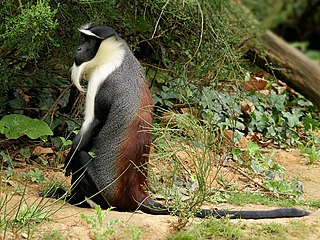
The Roloway monkey is an endangered species of Old World monkey endemic to tropical West Africa. It was previously considered a subspecies of the Diana monkey. The species is classified as Critically Endangered due to habitat loss and their continued hunting because of the bushmeat trade. The Roloway monkey is mainly an arboreal species, for the most part inhabiting forests in Ghana and some reserves in South-Eastern Côte-D'Ivoire. More specifically, studies have shown that C. roloway is primarily concentrated in the Tanoé forest of the Côte-D'Ivoire because of their heavy threats to extinction and lack of habitat. It is still difficult to gather data on wild subjects, as they have low populations in a vast forest, but they are a unique and vanishing species.
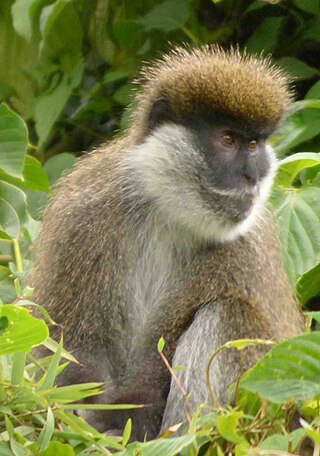
The Bale Mountains vervet is a terrestrial Old World monkey endemic to Ethiopia, found in the bamboo forests of the Bale Mountains. All species in Chlorocebus were formerly in the genus Cercopithecus. The Bale Mountains vervet is one of the least-known primates in Africa. They avoid tree-dominated and bushland areas as their habitat. These monkeys mainly reside in the bamboo forest of the Bale Mountains due their dietary specialization on bamboo, but other factors, such as climate, forest history, soil quality, and disease, are likely to play a role in their choice to inhabit this area. The Bale Mountains vervet have a very quiet behavior and tend to flee when encountering a human being. It is also known as the Bale monkey and Bale Mountain grivet.
The Afi Mountain Wildlife Sanctuary in Cross River State in southern Nigeria covers 104 km2 (40 sq mi). The wildlife sanctuary was founded in 2000 to provide refuge for endangered animal species, including the Cross River gorilla, the Nigeria-Cameroon chimpanzee, the drill and the gray-necked rockfowl.

The Niger Delta red colobus is a critically endangered species of colobus monkey endemic to the western part of the Niger Delta. It is threatened by hunting and habitat loss.

The roots of Edumanom Forest Reserve trace back to 1970 when it was singled out as one of the proposed Forest Reserves by the Rivers State Government, a compilation encompassing 11 distinct regions. At that time, the Governor of Rivers State, acting under the authority vested by Section 28 of the Land Use Act, rescinded all prevailing Rights of Occupancy associated with the land enveloping Edumanom Forest Reserve. Subsequently, the Commissioner of Agriculture and Natural Resources, sanctioned by Section 8 of the Forestry Law Cap 55 of the Laws of Eastern Nigeria, 1963, officially labeled the region as a forest reserve. The forest reserve derives its name from the Edumanom family in Otuabagi, the entity possessing the largest segment of the reserve.

The red-tailed monkey, also known as the black-cheeked white-nosed monkey, red-tailed guenon, redtail monkey, or Schmidt's guenon, is a species of primate in the family Cercopithecidae.

